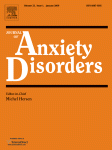Anxiety and Self-medication: Implications for Clinical Practice


Self-evaluation versus public evaluation
A Review of:
Robinson, J., Sareen, J., Cox, B.J., and Bolton, J.(2009). Self-medication of anxiety disorders with alcohol and drugs: Results from a nationally representative sample. Journal of Anxiety Disorders, 23, 38-45.
by Heather N. Goddard
Research across a variety of clinical and community based samples has concluded that anxiety disorders and substance use disorders are common comorbidities. Despite establishing that this frequent co-occurrence exists, few studies have offered a plausible explanation for the relationship. Robinson, Sareen, Cox, and Bolton (2009) attempted to explore one probable explanation know as the “self-medication hypothesis.” This hypothesis suggested that people with a primary diagnosis of an anxiety disorder attempt to self-medicate their anxiety symptoms which then develop into a substance use disorder. Previous research has attempted to explore this phenomenon on clinical samples which affect generalizability. Additionally, previous studies have failed to differentiate between methods of self medication, alcohol and/or drugs.
The current study includes individuals from the National Epidemiologic Survey on Alcohol and Related Conditions (NESARC) who met DSM-IV criteria for anxiety disorder (N = 7177). Participants were assessed for mood, anxiety, personality disorder, and substance use disorders. Method of self-medication was only assessed across four anxiety diagnoses (panic disorder, social phobia, specific phobia, and generalized anxiety disorder). Information was then gathered regarding type of self-medication employed; alcohol, alcohol and drugs, or no self-medication. Self-medication with drugs only encompassed an especially small group and was thus omitted. Lastly, sociodemographic data was compiled in regards to income, race, education, marital status, age, gender, and urbanicity.
Results indicated that rates of self-medication using alcohol were highest for those diagnosed with generalized anxiety disorder (18.5%), social phobia (16.9%), and panic disorder with agoraphobia (15.0%). No significant differences were found with regards to gender or other socio demographic variables.
Highest rates for self-medication with alcohol and drugs were panic disorder with agoraphobia (14.9%) and generalized anxiety disorder (7.4%). This type of self-medication was more common with men (55.8%) versus women (44.2%), younger age groups (18-44), separated or never married, lower income, and less educated.
Research supports the importance of a comprehensive assessment of drug and alcohol use when working with individuals diagnosed with anxiety disorders. With the addiction potential of many prescribed anxiety medications, clinicians need to inform individuals with the risk involved. Although properly prescribed medications may appear effective in the short-term, there seems to be an increased risk for substance use disorders with long-term or excessive use.
To cite this review, please use this reference:
Goddard, H. N. (2009). Anxiety and Self-medication: Implications for Clinical Practice (3). http://psychologyalert.com/2009/01/anxiety-and-self-medication.html
